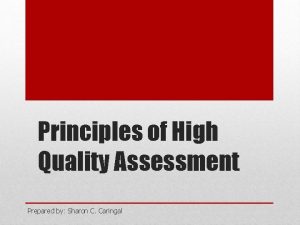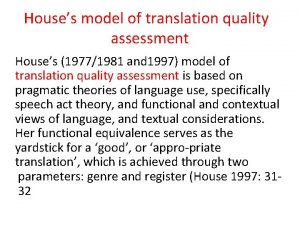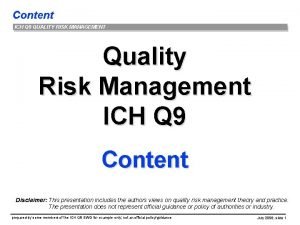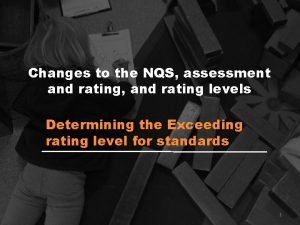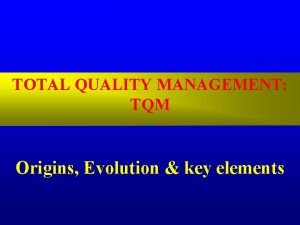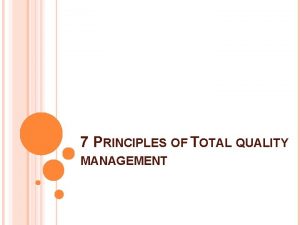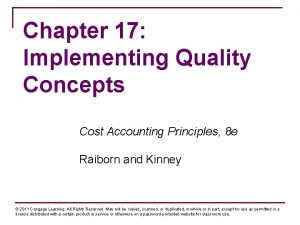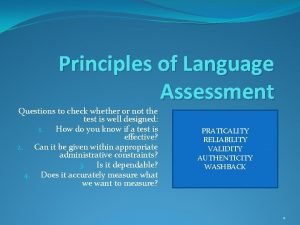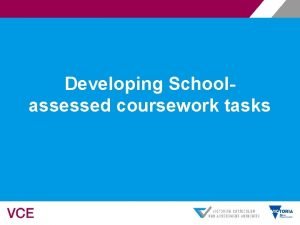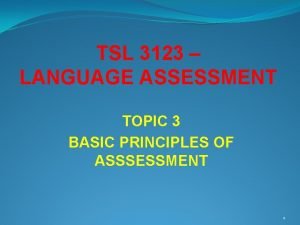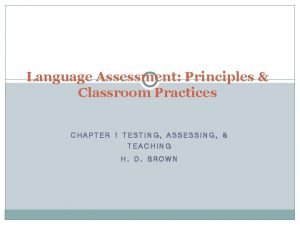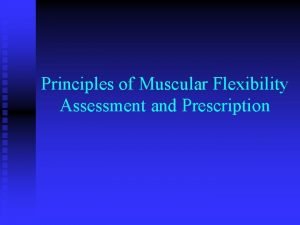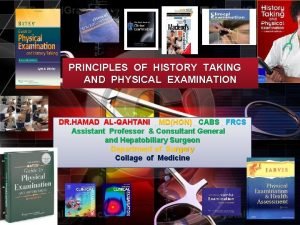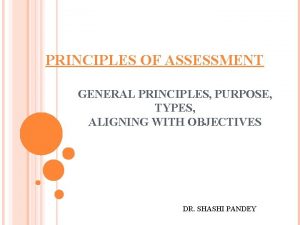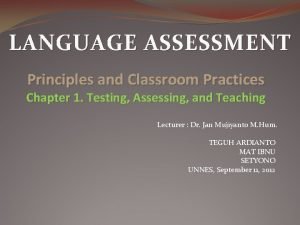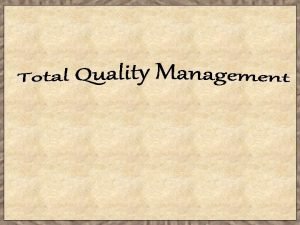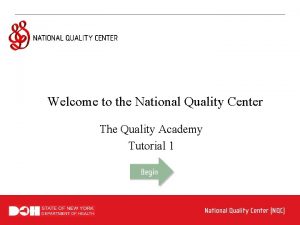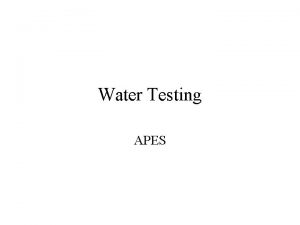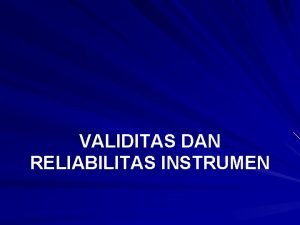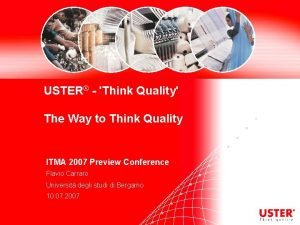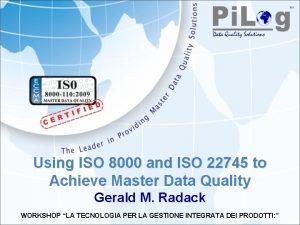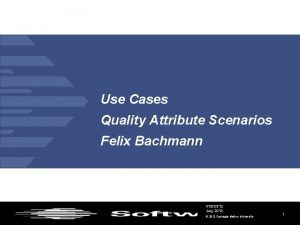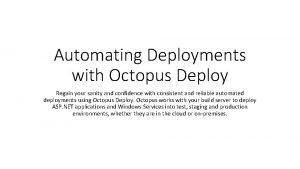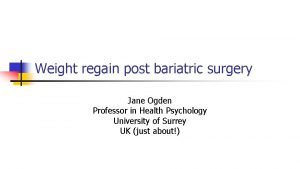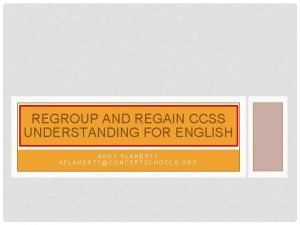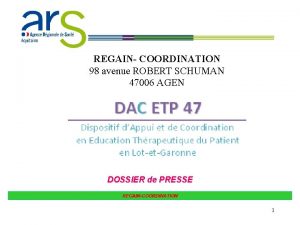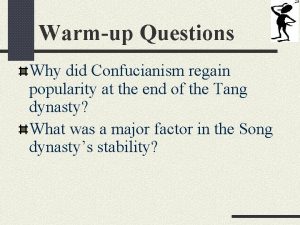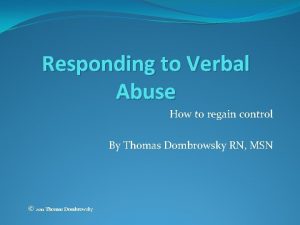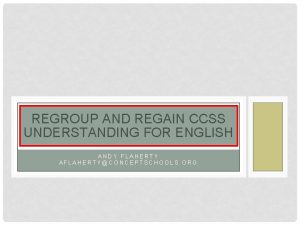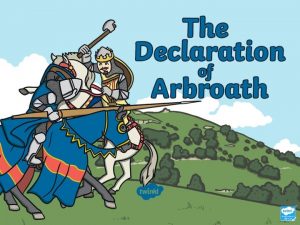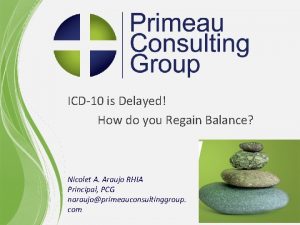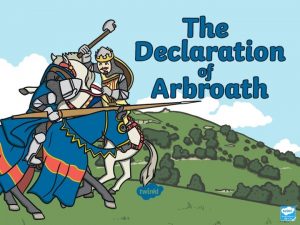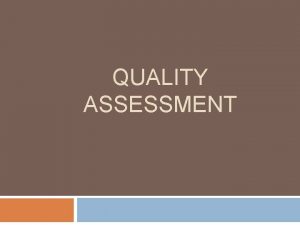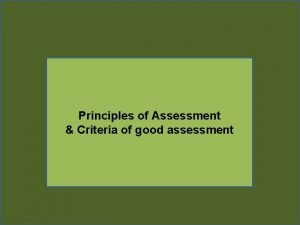Principles of quality assessment or How to regain


















































- Slides: 50

Principles of quality assessment or How to regain your weekends

So I can rank you from A-E everyone has to take the same exam: please climb that tree


Reporting vs assessment

BRAINSTORM What are the features of quality assessment practice?

Pause the video now to complete the brainstorm and share with the group

Assessment should: • be relevant (linked to syllabus outcomes) • be appropriate (measures what it intends to measure) • be fair (opportunity for all students to demonstrate what they learnt) • be accurate (reliable and valid) • provide useful information – of learning (summative) – for learning (formative)

Assessment is about helping students to learn better. . . . rather than just get a better grade.

Assessment should. . . • address groups of outcomes • enable teachers to make judgements which: – inform teaching and learning – provide quality feedback to students – provide a basis for reporting to parents.

Quality assessment practices Some guiding principles The A – E guide!


Achievement: understanding and articulating what students know and can do. Accountability: evidence that demonstrates what students know and can do.


Balance: ensuring on-balance judgements are made using evidence from a range of student performances not just one-off, point in time tasks.


Consistency: when teachers are able to make judgements about student learning that are independent of: • individual teacher • student • location • time


Ensure our judgements are equitable and fair

w o H

Collaboratively plan teaching programs which clearly state the intended learning Collaboratively develop common assessment practices


D of assessment Dialogue: • Build in structured time to talk with other teachers • Discuss outcomes and what they mean / look like • Use work samples collaboratively • Share understandings of student achievement at a particular point.


Educative: assessment should be an integral part of teaching and learning Evaluative: assessment information should drive your teaching


Evidence: collecting many pieces of a puzzle to make an on-balance judgement

Recording evidence • How much? • Why? • When? • How?

Recording evidence • How much? • Why? • When? • How?

Recording evidence • How much? • Why? • When? • How?

Recording evidence • How much? • Why? • When? • How?

What learning activities, tasks or performances. . . will provide students with an opportunity to demonstrate evidence of their learning?

What might you observe students doing, saying or producing that will support you to make an on-balance judgement?

Collecting evidence of learning

What constitutes evidence? (assessment tools) • • • work samples practical performances group presentations group and class discussions responses to questions observations of students working in-class tasks tests take home assignments

Considerations when selecting assessment tools • time efficiency (both the students’ time and yours) • reliability within a class • consistency of judgement across classes

Recording evidence


Feedback is amongst the most powerful influences on achievement John Hattie

Effective feedback

When should you give feedback? Feedback is most powerful if it is given to students while there is still time for them to adjust and perfect their efforts.

Types of feedback

Tailoring feedback

Creating maximum learning effect – Transparent goals – Success criteria – Quality feedback Focus on performance against a standard not performance against other students Hattie: Visible Learning, 2008 Routledge

Prior to task completion • Describe how responses will be measured and why (transparent goals) • Set exemplary standards, provide these to students (success criteria) • Provide sample exemplary responses (success criteria)

During completion of task Quality feedback • Provide frequent and informative feedback about draft responses to task. • This should be expressed as a comparison to the exemplary standard.

After task completion • Provide rich feedback as soon as possible • Support students to troubleshoot their own responses • Provide explicit information about what was deficient and how to remedy it.

Feedback for you. . . You should be using assessment of how students are going as feedback on how successful your teaching has been. John Hattie

Follow up from assessment • Do some concepts need to be revised? • Do you need to provide further practice or clarity? • Is there benefit in peer tutoring? • Is the time right to deepen their understanding of this concept? • Is the time right to move on to a different concept?

In summary. . Assess what is taught Integrate as part of the teaching and learning process Elicit a range of performance Provide multiple ways and opportunities to demonstrate understanding and skills Provide timely, quality feedback

Faculty reflections • How do you currently assess your students? • What is working well? • How do you collect and collate evidence of student achievement? • What assessment strategies do you use currently? • How confident are you that report grades accurately reflect achievement?
 Act 4 scene 2 romeo and juliet
Act 4 scene 2 romeo and juliet How to earn your parents trust back
How to earn your parents trust back If garden gnomes regain popularity, what will happen?
If garden gnomes regain popularity, what will happen? Stop working phrasal verb break
Stop working phrasal verb break Principle of high quality assessment
Principle of high quality assessment Principles of quality assessment
Principles of quality assessment Quality control and quality assurance
Quality control and quality assurance Quality management pmp
Quality management pmp Quality metrics pmp
Quality metrics pmp Define quality assurance in nursing
Define quality assurance in nursing Compliance vs quality
Compliance vs quality Concept of quality assurance
Concept of quality assurance Quality gurus of tqm
Quality gurus of tqm Quality is free
Quality is free What is tqm
What is tqm House model translation
House model translation Ich 9
Ich 9 National quality standard assessment and rating instrument
National quality standard assessment and rating instrument Deming chain reaction
Deming chain reaction Principles of quality assurance
Principles of quality assurance Quality training principle
Quality training principle 7 principles of total quality management
7 principles of total quality management Quality management principles in food and beverage company
Quality management principles in food and beverage company Quality principles and concepts
Quality principles and concepts Portfolio assessment matches assessment to teaching
Portfolio assessment matches assessment to teaching Define dynamic assessment
Define dynamic assessment Portfolio assessment matches assessment to teaching
Portfolio assessment matches assessment to teaching Principles of language assessment
Principles of language assessment Vce assessment principles
Vce assessment principles Authenticity principles of language assessment
Authenticity principles of language assessment Representing motion physics answers chapter 2
Representing motion physics answers chapter 2 Language assessment principles and classroom practices
Language assessment principles and classroom practices Principles of assessment flexibility
Principles of assessment flexibility Principles of history taking
Principles of history taking Purpose of assessment
Purpose of assessment Principles of assessment
Principles of assessment What is summative evaluation
What is summative evaluation Dppm quality
Dppm quality The quality or state of being free
The quality or state of being free Quality is meeting or exceeding customer expectations
Quality is meeting or exceeding customer expectations Quality weld service
Quality weld service Bruce agins
Bruce agins Quality first teaching checklist
Quality first teaching checklist Tds apes
Tds apes Water quality act of 1965
Water quality act of 1965 Wardaccreditationprogramme
Wardaccreditationprogramme Contoh validitas konvergen
Contoh validitas konvergen Uster think quality
Uster think quality Iso 8000 data quality
Iso 8000 data quality Quality attribute workshop
Quality attribute workshop Usability quality attribute that assesses
Usability quality attribute that assesses




